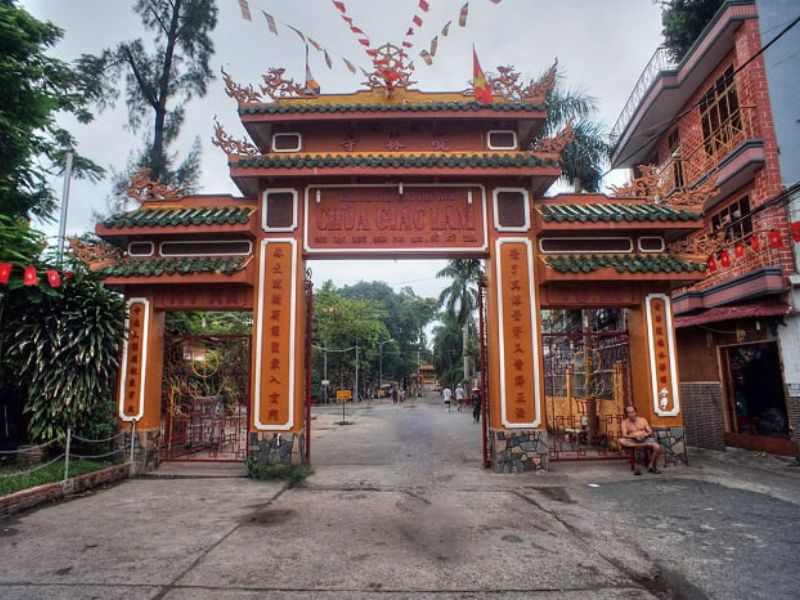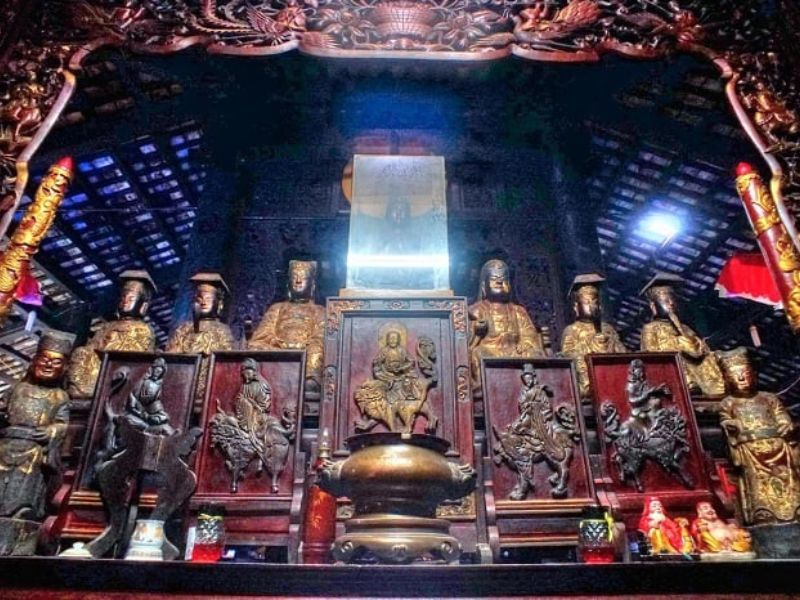Located on the land of Ho Chi Minh City, Giac Lam Pagoda is not only a religious symbol but also a historical picture with colorful developmental stages. Join DanangPrivateCar.com’s to explore Giac Lam Pagoda to learn about its history, distinctive architecture, and fascinating activities at this temple through the following article.
Where is Giac Lam Pagoda?
- Phone: 028 3865 3933
- Opening hours: 7:00 AM – 9:00 PM
- Address: 565 Lac Long Quan, Ward 10, Tan Binh District, Ho Chi Minh City 70000
Giac Lam Pagoda is located at 565 Lac Long Quan, Tan Binh District, Ho Chi Minh City. This is one of the ancient and largest pagodas in Saigon, recognized by the Ministry of Culture – Information as one of Vietnam’s national historical and cultural heritage sites.
Moving to Giac Lam Pagoda
To get to Giac Lam Pagoda in Ho Chi Minh City, you can use public transportation or private transportation services. Here are some popular methods:
- Taxi: Note the address: 565 Lac Long Quan, Ward 10, Tan Binh District, Ho Chi Minh City. Call a taxi or use a mobile app to book a ride.
- Private Car: For convenience in pre-planned transportation, door-to-door service, and a comfortable journey, booking a private car with a driver in Ho Chi Minh City from DanangPrivateCar.com’s can meet all your needs.
- Bus: If you prefer public transportation, you can check the bus routes that pass through the Giac Lam Pagoda area.
- Motorbike Rental: If you want to explore the city more freely, you can rent a motorbike in Ho Chi Minh City and then ride to the pagoda.
- Walking: If you are nearby, walking is also a feasible option to reach Giac Lam Pagoda.
Before starting your journey, check the traffic information and address to ensure that you have the correct and most convenient route.
History of Giac Lam Pagoda
Giac Lam Pagoda, also known as Phat Bao Pagoda, is one of the temples with a history of 300 years. This place attracts many locals and tourists to visit and worship every year. If you have the opportunity to travel to Ho Chi Minh City, don’t miss the chance to visit this temple! Now, let’s explore the historical journey of Giac Lam Pagoda with DanangPrivateCar.com below.
- Ancient period: In the spring of 1744, Giac Lam Pagoda was initiated by the monk Ly Thuy Long under the reign of King Nguyen Phuc Khoat. The temple was initially known by various names such as Cam Son, Son Can, and Cam Đệm.

- Name change and development: Zen master Phat Y-Linh Nhac sent his disciple Vien Quang to take over the temple. Since then, the temple was renamed Giac Lam and became a center for training scriptures and legal principles for Buddhists in Gia Dinh and the Southern region.
- Significant period: In history, Giac Lam Pagoda served as a hiding place for many revolutionaries during the wartime of 1939-1945. This was also the time when the temple underwent another renovation.
On the 3rd day of the lunar December in the year of Dinh Hoi (1827), Zen master Vien Quang passed away, and Zen master Hai Tinh succeeded him. By 1873, under the abbacy of Zen master Minh Khiem, Giac Lam Pagoda was a place for printing books, woodblock carving, and spreading Buddhist knowledge to the people.
In 1988, Giac Lam Pagoda was officially recognized by the Ministry of Culture – Information as a National Historical and Cultural Relic.
- Giac Lam Pagoda today: From its establishment until now, Giac Lam Pagoda has gone through eight generations of abbots. The current abbot of the temple is Most Venerable Thich Hue Trung, the head monk is Venerable Thich Tu Tanh, and the deputy head monk is Venerable Thich Tu Tri. Giac Lam Pagoda continues to attract thousands of tourists and Buddhists each year to visit and learn about the history and culture of Buddhism.
Exploring Unique Architecture at Giac Lam Pagoda
Nestled peacefully amidst the vibrant life of Ho Chi Minh City, Giac Lam Pagoda is a historical gem carrying unique architectural features and fascinating stories about the beliefs and culture of Southern Vietnamese Buddhism. Follow the travel guide from DanangPrivateCar.com to learn about the architectural structures of Giac Lam Pagoda!
Distinctive Architectural Beauty of Southern Pagodas
To this day, Giac Lam Pagoda maintains architectural features deeply rooted in the culture and traditional style of Southern pagodas from the past. The pagoda is designed in the shape of the Greek letter chi (Ξ), with three horizontal rows interconnected, arranged in a rectangular layout including the main hall, lecture hall, and monks’ quarters.

Twin Gate
The twin gate of Giac Lam Pagoda was completed in 1945, featuring two lions at the corners, representing the cultural influence of India and the distinctive Naga serpent symbol of Khmer Buddhism. The gate is designed with kneeling legs, adorned with characteristic embossed patterns. Above the gate, there is an inscription in Chinese characters telling the legend of Prince O Quan in the Tang Dynasty. Additionally, the gate is not built straight towards the main hall, following ancient beliefs to prevent spirits from entering the main area of the temple directly.
Triple Gate
Originally, Giac Lam Pagoda did not have a triple gate. It was not until 1955 that the pagoda began to build the triple gate facing south, near the present-day Lac Long Quan Street. Both sides of the pillars are engraved with Chinese couplets. Importantly, the temple gate is always open to welcome those who want to learn and follow the teachings of Buddhism.

Giac Lam Pagoda Roof
The pagoda roof is designed in the shape of a traditional Southern Vietnamese hat, creating a sense of intimacy and friendliness with the locals. The roof has four slopes, straight, and without the typical eave seen in northern temples. At the peak of the roof is the image of “double dragons fighting over a pearl,” symbolizing solemnity and respect for the Buddha’s teachings.

Main Hall Area
In front of the main hall is a rectangular courtyard, 20m in width and 10m in depth. Here, there is an altar with statues of Amitabha Buddha, Shakyamuni Buddha, Maitreya Buddha, and two side altars with statues of Avalokiteshvara Bodhisattva and Mahasthamaprapta Bodhisattva. The ancestral shrine is very solemn, consisting of three altars arranged in descending order: the altar of Amitabha Buddha, the Council altar, and the Triple Gem altar.
The main hall of Giac Lam Pagoda has four main columns called “four pillars,” symbolizing “worshiping the Buddha, honoring the Ancestors.” In addition, there are a total of 56 large columns. Each column is meticulously crafted, engraved with couplets and decorated with gold foil. Among the columns, traditional decorative themes such as the four supernatural creatures, the four seasons, and floral patterns are depicted.
The interior of the main hall of Giac Lam Pagoda is vibrant and luxurious. Here, you can find many large statues such as the statues of Amitabha Buddha, Shakyamuni Buddha, Maitreya Bodhisattva, Avalokiteshvara Bodhisattva, and the impressive Nine Dragons bronze statues. A special feature here is the presence of 2 sets of Eighteen Arhats and 2 sets of Ten Kings of Hell statues.
The top of the main hall wall and the Hong Hung ancestral tower have more than 7,000 decorative plates. Of these, more than 6,000 plates are used on the main hall wall, and more than 1,000 plates are on the Hong Hung tower. These decorative plates are mainly produced from the Lai Thieu pottery kiln in Binh Duong, along with some imported plates from Japan and China. This makes Giac Lam the temple with the “largest number of decorative plates in Vietnam.”
Behind the main hall area of Giac Lam Pagoda is the ancestral shrine, where the ancestral tablets of the temple’s abbots are enshrined according to each period. Opposite the ancestral shrine is the altar of the Standard Set Buddha, Amitabha Buddha, and the Ten Kings of Hell.

Near the ancestral shrine area is the lecture hall, built in the style of the main hall roof. This is where monks and disciples often attend important events and major festivals at Giac Lam Pagoda. During the resistance against French and American forces, the lecture hall was also used to train personnel and carry out reconnaissance missions in the urban area.
What is Attractive about Giac Lam Pagoda?
In addition to the mentioned architecture, Giac Lam Pagoda has some outstanding structures that you shouldn’t miss when visiting this place:
- The ancient tomb tower area at Giac Lam Pagoda was built from the early 19th century to the early 20th century, honoring monks and nuns when they passed away.
- Bao Thap Xa Loi – a hexagonal-shaped structure with seven floors, began construction in 1970 according to the design of architect Vinh Hoang. The construction was temporarily halted in 1975 and completed in 1994, with a height of 32.7m and a floor area of over 600m2, facing north.

The bottom floor of the tower houses the altar of the Three Jewels Buddha, and the subsequent floors feature altars dedicated to various Buddhas and Bodhisattvas such as Shakyamuni Buddha, Medicine Buddha, Avalokiteshvara Bodhisattva, etc. The top floor is adorned with the Nine Dragons cluster, with the Xa Loi tower featuring the image of Shakyamuni Buddha.
- Giac Lam Pagoda has a hall with 119 Buddha statues, including wooden statues of Shakyamuni Buddha, bronze statues of infant Shakyamuni Buddha, as well as statues of the Eighteen Arhats and the Five Saints. The set of Eighteen Arhats is a clear symbol of the development of Southern Buddhism and the distinctive characteristics of the Vietnamese people. In addition to the statues, the pagoda also houses many precious wooden artworks such as embroidered screens, horizontal lacquered boards, gilded couplets, altars, and ancient worship items.

Festive Activities at Giac Lam Pagoda
During important holidays such as the 1st and 15th day of the lunar month or the Vu Lan Festival, Giac Lam Pagoda attracts a large number of monks, Buddhists, and tourists. This is an opportunity for you to participate in Buddhist ceremonies, pray for peace, and enjoy the solemn and respectful atmosphere at the temple.
Furthermore, Giac Lam Pagoda organizes various special religious activities such as Buddha’s birthday celebration and requesting blessing characters. You can also participate in retreats to listen to Buddhist teachings and cultivate the virtue of patience. Engaging in these activities helps deepen your understanding of Buddhist teachings and experience the sacred atmosphere while praying for your family and loved ones.
Concluding your exploration of Giac Lam Pagoda, it is hoped that you not only carry with you beautiful images of the sacred corners and unique architecture of the temple but also gain knowledge about the history of Giac Lam Pagoda. See you again through articles about other famous temples on DanangPrivateCar.com’s!

